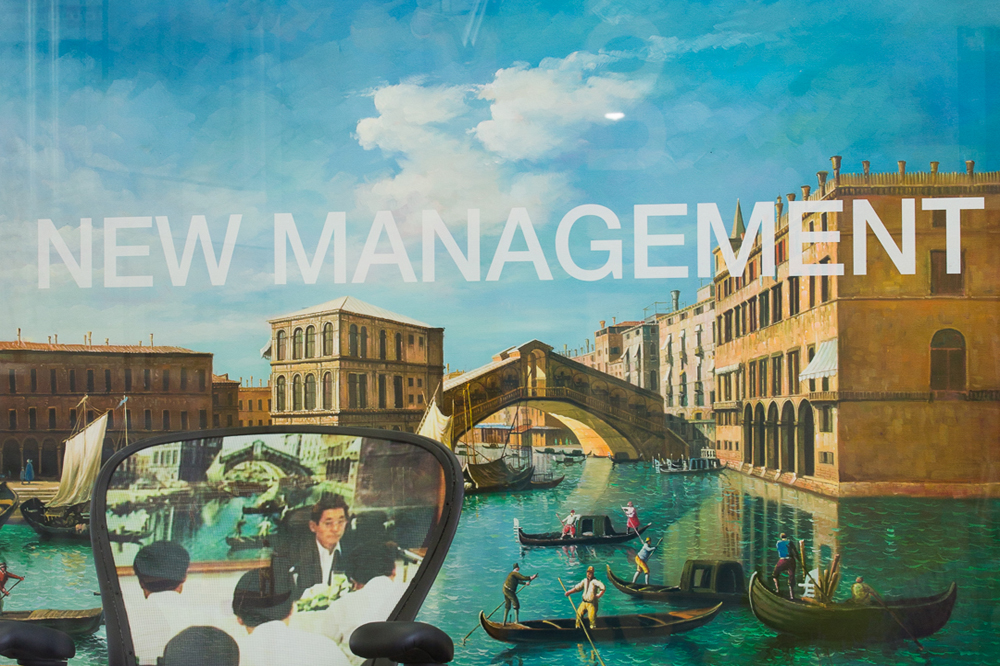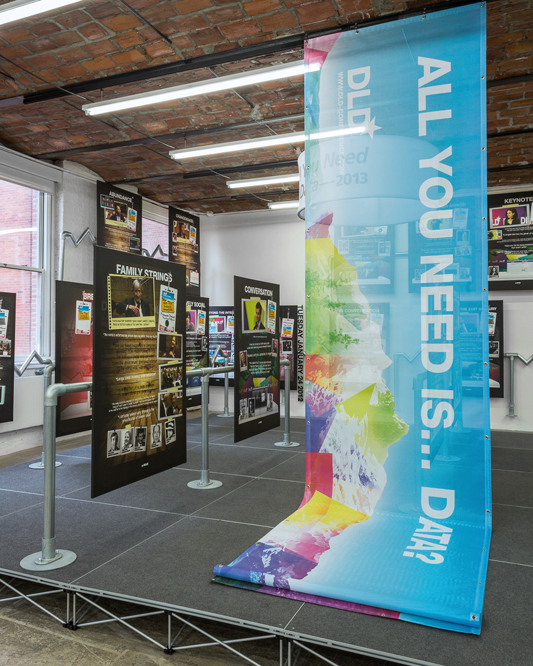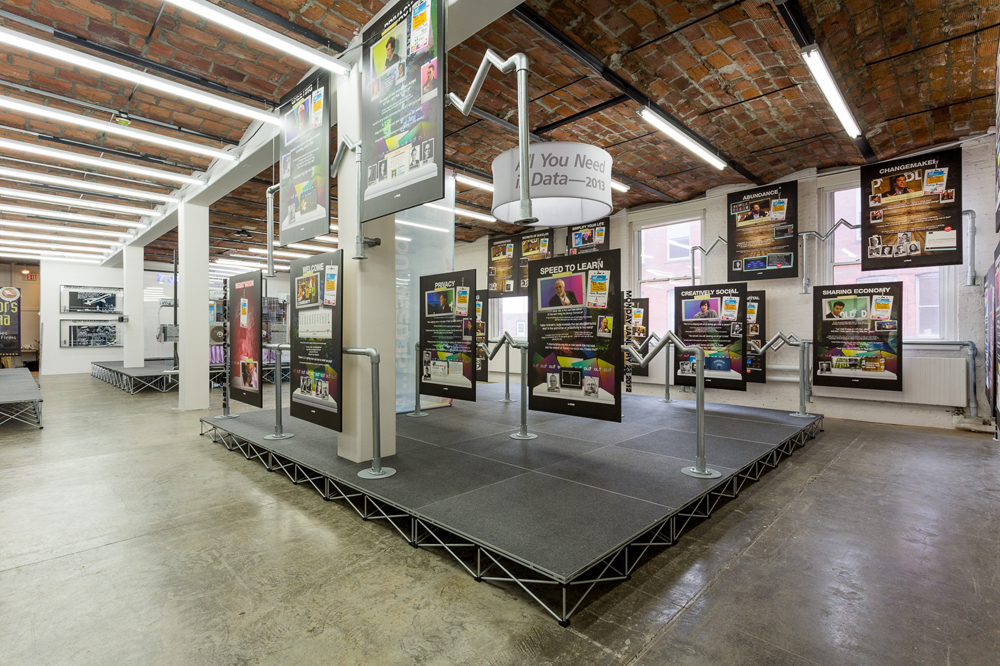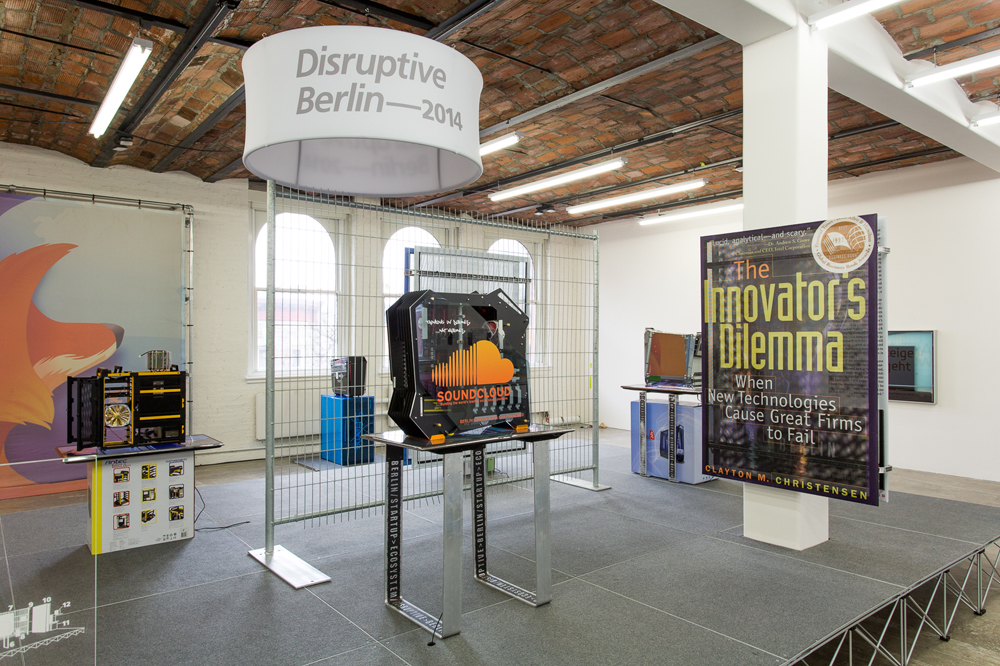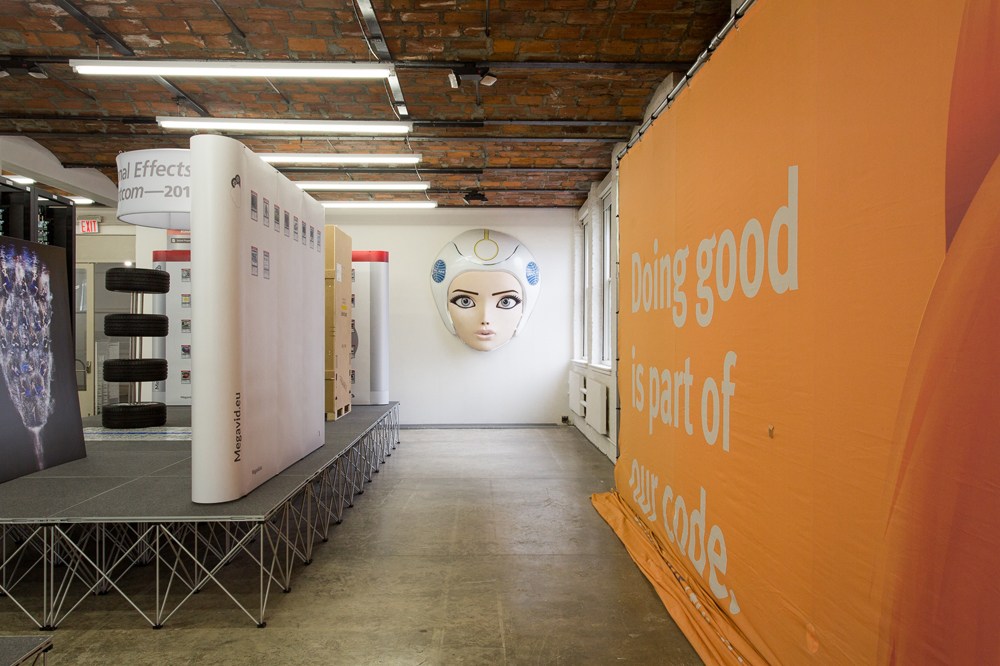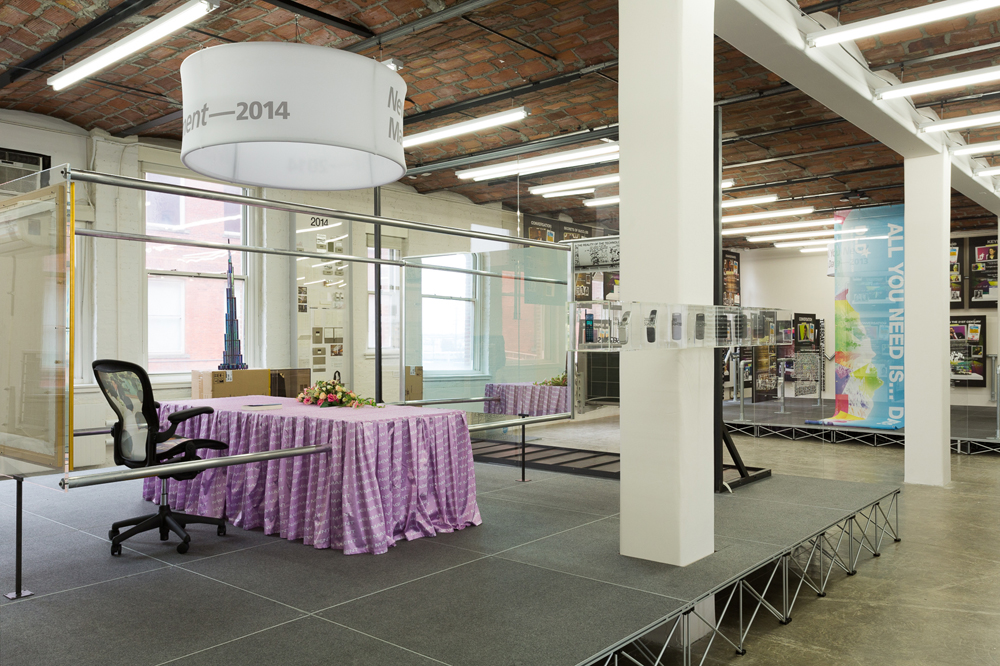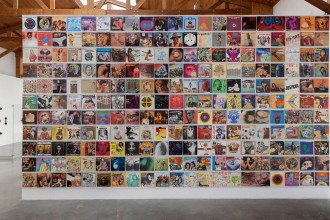I’d always thought of the word “disruptive” as a negative term before immersing myself in Simon Denny’s quasi-retrospective at MoMA PS1. The exhibition takes its title, The Innovator’s Dilemma, from a best-selling book of entrepreneurial theory written by Clayton M. Christensen in the late nineties. Christensen argues that corporations are unlikely to invest in forward-thinking technologies, given consumers’ lack of current need. He asserts that companies should invest in so-called “disruptive innovations” in order to anticipate the future consumer. As we have seen in the rapid advancement of smart technology and social media, “disruptive innovations” can drastically transform the wider social, political, and cultural landscape, leaving a trail of defunct objects and communicative strategies in their wake (the cellphone, for example has rendered the fixed-line telephone and the public payphone practically obsolete). Disruption, therefore, does not necessarily denote a frustration or a holding back. In this context it signals a surge forward.
Throughout his relatively young career, Denny, 33, has explored the effects of tech innovation by focusing on specific events, publications, and figures in recent history that have come to shape the consumer-driven, app-filled world we now inhabit. Adding a conceptual framework to an already loaded practice, The Innovator’s Dilemma is curatorially devised in the guise of a trade show, taking elements of Denny’s installations to date and presenting them in bite-size renditions through the aesthetics of industry display.
This is not an overtly likeable means of presentation. By virtue of its subjects and Denny’s assimilation into their world, The Innovator’s Dilemma is somewhat of a cold and alienating beast, irritatingly populated with bombastic buzz speak and accompanied by an unrelenting soundtrack of tinny techno. Each work is afforded its own territory via staging and banners, yet the sounds, screens, and subjects of these bleed together. Even the information panels are (unhelpfully) printed as white text grafted onto freestanding transparent surfaces, allowing the words to recede against the gallery walls and artworks. The romanticized notion of the artist is in many ways the very antithesis of corporate aesthetics, but the trade show format (however initially off-putting) does feel justifiable in light of Denny’s oeuvre. The technological world that he casts as his muse is one in which everything is hyperlinked, and fittingly, the exhibition appears less as a fixed entity but a shifting, overlapping interface.
Take, for example, All You Need is Data (2013), Denny’s visual summary of the 2012 Munich conference Digital Life Design – a global exchange platform bringing together leading figures from the fields of technology, science, culture, and politics. Presented at MoMA PS1 are a selection of the 89 display panels featured in the original installation (shown at Kunstverein Munich and coinciding with the 2013 DLD conference), each condensing talks and discussions held during the event into pull quotes and kitsch graphic visuals – a layout, I later learned, based on the then-current iPhone iOS 5 operating system. The panels are supported and interconnected by a snaking metal framework, which seems to symbolize the flow of information, ideas, and exchange. Yet, despite its basis in communication, All You Need is Data presents a total over-saturation of information from which it’s difficult to extricate any solid fact or concept. The aforementioned “buzz speak” abounds (“Everyone now has the power of voice” – Sheryl Sandberg, Facebook COO; “I never look in the rearview mirror, it’s the next thing I’m always focused on” – Nolan Bushnell, Creator of Pong). It is a work from which we are, frustratingly, twice removed, firstly from the wider conference context from which the quotes are plucked, and secondly from the original artwork, in its whole.
The idea of “disruptive innovation” is most obviously explored in Denny’s recent body of work Disruptive Berlin (2014). Berlin, in addition to its long-running reputation as a haven for artistic production, is gaining new prominence as the digital start-up capital of the world. In recognition of this status, and adopting Christensen’s terminology, Denny presents totem-like sculptures in homage to the top ten Berlin start-ups of 2013 (as voted by Wired Magazine). Unlike much of Denny’s earlier works, which reflect upon events that have already taken place, the Disruptive Berlin sculptures appear more creatively intuitive, using elements of app branding combined with screens and hardware to formally solidify these otherwise largely intangible new products into physical art objects.
It was this application of art to embody technological innovation that, for me, enhanced the slippage between art and technology in Denny’s complex practice. The notion of “disruptive innovation” can just as easily be applied to the artworld as to the fields of technology and business. However, artists are able to seismically shift existing aesthetic responses to societal events through alternative ways of thinking and imaging, without the necessary pressure to create useful products, too.
Rather than holding the field of technological marketing and management at arm’s-length from that of the artistic creative, Denny expertly suggests parallels between the two. The abstract, conceptual innovations recognized in Disruptive Berlin represent a creative avant-garde. Like any period of contemporary development, technological innovations have their own aesthetic, vernacular, exhibition platforms, and their own inner circle of supporters and critics.
Denny approaches his subjects with a mixture of criticality and admiration. In New Management (2014) we see the partial recreation of a glossy Frankfurt hotel room, a “historic’ site in which Samsung’s chairman Lee Kun-hee launched his “New Management” philosophy to a gathering of top executives in 1993. This watershed event in the company’s history (credited with instigating Samsung’s rise to global corporate giant) is celebrated in the form of a diorama at Samsung’s education facility in South Korea. Denny’s version, fueled in part by knowledge of this diorama, appears almost as an exploded technical diagram, offering elements of hotel furnishings including, amusingly, a fake Canaletto painting branded with the term “New Management.” Bookending Denny’s display, air-conditioning units emblazoned with Lee’s famous slogans such as “change begins with me” serve as a visual metaphor for the recirculation and distribution of new-management philosophies, while Samsung’s hardware evolution is demonstrated via a chronological display of its mobile phones. New Management is, in part, educational, yet Denny has developed his own visual operating system through which the information is channeled and shared.
A museological approach continues with The Personal Effects of Kim Dotcom (2013). Responding to Dotcom’s arrest in 2012 (for crimes connected to piracy and copyright fraud through his sites Megaupload and Megavideo), Denny presents facsimiles of Dotcom’s personal effects seized during the police investigation. It’s a fascinating if bizarre collection, populated with “fan boy” merchandise and the usual nods to luxury lifestyle, including a looming wall sculpture by artist Colin Christian, which provides an obvious example of the technology market feeding the art market. Dotcom’s possessions (of which we see only a small selection in The Innovator’s Dilemma) also troubles the personality of the entrepreneurial innovator, the tech nerd, the luxury consumer, and, in particular, the subjects of distribution and copyright.
Although the installations in The Innovator’s Dilemma are reduced from their previous renditions, they do not appear as formally lacking. If anything, Denny’s condensed adaptations echo the evolution of much of the technology and ideology that he is fascinated by, while still managing to output a heady stream of visual and textual data. The trade-show format, for all of its surface irritations, comes across as an edgy experiment, an opportunity for Denny to slip further still into the world of tech innovation, even if the results are not exactly user-friendly.
As if to acknowledge this, on the way out of the exhibition, we are met with a faux Samsung flat-screen television displaying a collage from industry magazine Corporate Video Decisions. The centralized front page knowingly asks “Trade Show Overkill?” The answer immediately following time spent in The Innovator’s Dilemma is undoubtedly “yes.” It’s a fatiguing viewing experience, which, despite its focus on some of the more human origins behind technological innovation, still feels coolly distanced and leaves little room for sentiment. Denny’s dedicated observations are admirable, his research impressive, and the work unquestionably intelligent. Perhaps in the ruthless world of “disruptive innovation,” as laid out in Christensen’s book, it is irrationally human to seek a deeper emotional connection. But I left The Innovator’s Dilemma with the certainty that I needed more than just data.

